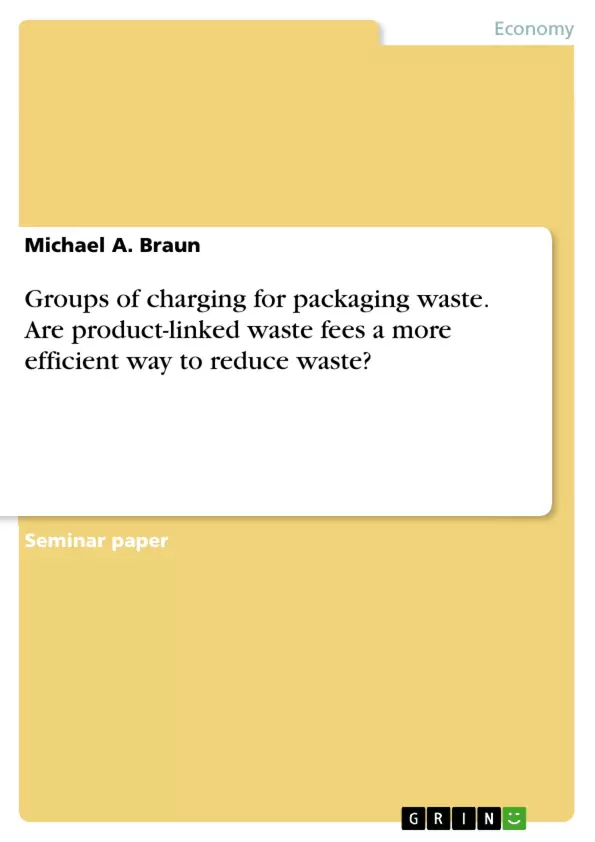Whether waste is an economic good or bad is already not clear decided (although this is changing in the last years) – and probably can not as well. Instead this depends on different assumptions that have to be made and about the way how a system is installed.
But as a main thesis, the essay proclaims and analyses the ‘hierarchy theory’ which focuses on the “R’s” – reduction, reuse, recycling and recovery. The priority of reduction is in most of the western countries accepted, and only the transformation into practical guidelines and legislation needs to be improved sometimes, as examples show.
For a successful introduction of such organized waste management system it is necessary to have political support as well a support of all other groups involved. To gain this, especially of consumers, information and education helps. Moreover, clear benefits for businesses have to be provided so that they are encouraged to invest in new technologies and innovation. Therefore, related to the experiences made with the Duales System Deutschland (DSD) in Germany, some practical guideline are discussed and stated.
Inhaltsverzeichnis (Table of Contents)
- OVERVIEW
- THREE GROUPS OF CHARGING FOR PACKAGING WASTE IN OVERVIEW - ARE PRODUCT-LINKED WASTE FEES A MORE EFFICIENT WAY TO REDUCE WASTE? - ESSAY BASED ON EXPERIENCES OF THE GERMAN DUALES SYSTEM (GREEN DOT).
- Charging For Packaging Waste
- Three Groups Of Charging
- Pre-Paid
- Traditional
- Innovative
Zielsetzung und Themenschwerpunkte (Objectives and Key Themes)
This essay explores different methods of charging for packaging waste, focusing on their efficiency in reducing waste. The primary goal is to assess the effectiveness of product-linked charging schemes, particularly the German Duales System with its Green Dot, in promoting environmental sustainability. The essay evaluates the implications of each method, including pre-paid, traditional, and innovative approaches.
- The effectiveness of various charging systems for packaging waste.
- The role of product-linked charging in reducing waste quantities.
- The environmental impact of different waste management strategies.
- The economic implications of charging for packaging waste.
- The challenges and benefits of implementing innovative waste management systems.
Zusammenfassung der Kapitel (Chapter Summaries)
The essay begins by highlighting the issue of packaging waste and its complexities. It discusses the dual nature of packaging waste as both a resource and a pollutant, emphasizing the need for effective waste management strategies. The author then delves into the hierarchy of waste management practices, prioritizing waste reduction, reuse, and recycling over disposal. The essay examines the costs associated with waste management, distinguishing between visible and hidden costs. It further explores the role of political support, education, and cost-effectiveness in successfully implementing innovative waste management systems.
The main body of the essay focuses on three groups of charging for packaging waste: pre-paid, traditional, and innovative. The pre-paid group includes waste bag and tag/sticker schemes, where customers pay upfront for waste collection services. The traditional group encompasses volume-based and frequency-based charging, where customers pay based on the amount or frequency of waste collection. The innovative group, which is not discussed in detail in this preview, likely focuses on more contemporary approaches to waste management, potentially including recycling incentives, deposit-return schemes, or extended producer responsibility models.
The essay delves into the implementation challenges and potential benefits of each charging group, highlighting the impact on consumers and producers. The emphasis is on the effectiveness of product-linked charging in reducing waste quantities and promoting environmental sustainability. The example of the German Duales System with its Green Dot is presented in depth, demonstrating the potential of such schemes to drive both waste reduction and innovation in manufacturing and packaging.
Schlüsselwörter (Keywords)
The key terms and concepts explored in this essay include packaging waste, waste management, charging systems, product-linked fees, waste reduction, recycling, environmental sustainability, economic implications, and the German Duales System with its Green Dot.
- Quote paper
- Michael A. Braun (Author), 2003, Groups of charging for packaging waste. Are product-linked waste fees a more efficient way to reduce waste?, Munich, GRIN Verlag, https://www.grin.com/document/42775



